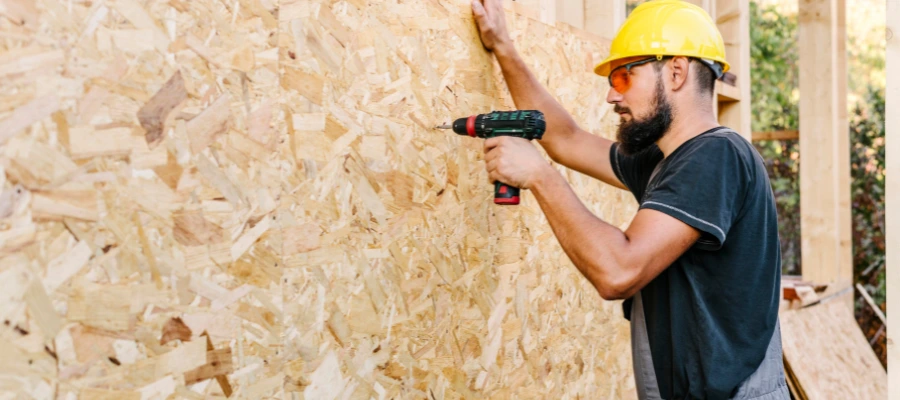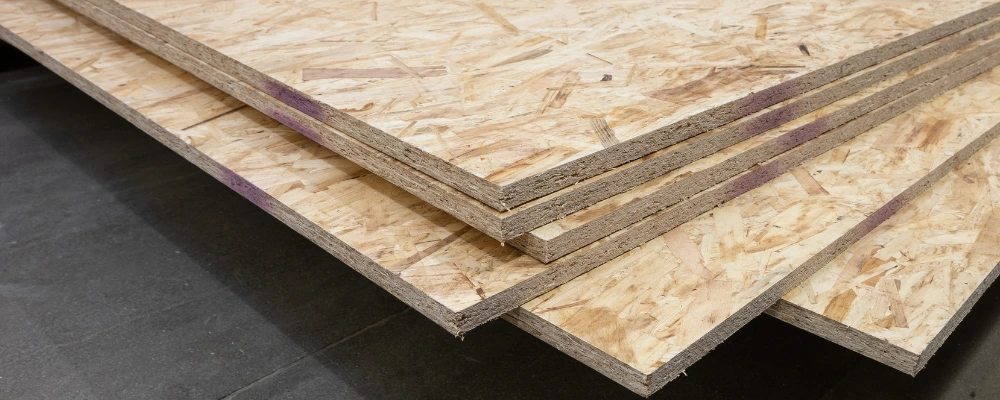Over the last few years, many engineered wood products have been gaining popularity in the AEC (Architecture, Engineering and Construction) industry. This is because they are more sustainable alternatives to solid wood, but retain almost similar properties of strength and aesthetics. One such product is an Oriented Strand Board (OSB). Read on to learn exactly what an oriented strand board is, its types, advantages and limitations, the applications of OSB boards in buildings and the OSB prices in India.
What is OSB?
Oriented strand board (OSB) is an engineered wood product made by compressing and glueing together wood strands. It was invented and patented by engineer Armin Elmendorf in the 20th century as a strong alternative to solid wood and has since been used in diverse applications, especially in the building industry. Although OSB and plywood are different, OSB is commonly referred to as plywood strand board or OSB plywood.
How are Oriented Strand Boards Made?
The different types of wood are procured and shredded into strips in factories that manufacture OSB sheets. Each strip has a size of around 2.5cm x 15cm. These strips are laid on a belt which is heated and resin is applied to bond these strips together to form a thin layer. Different layers are then placed on top of each other, with the mean direction of strips in one layer being perpendicular to that of the subsequent layer. The total number of layers depends on the thickness of the panel required. These layers are then coated with wax and resin (generally formaldehyde based) and then compressed in a thermal press under high temperature and pressure. The final OSB wood obtained is typically 1/10th of the thickness before compression. These panels are then cut into the required sizes and shipped.
Benefits of Using OSB
- High Strength: An OSB has extremely high strength and can be used for structural as well as non-structural applications. Its shear strength is almost twice the value of other engineered wood products like plywood and it has high resistance to breaking and cracking.
- Aesthetic Quality: OSB boards have a very unique visual appearance. They look uniform on all sides and unlike plywood, they do not consist of any timber defects like knots or twists. They can be left exposed without the need for any painting, polishing or wood veneers.
- Sustainability: This board is often made using wood that is leftover as waste from the manufacturing process of other engineered wood products. In other cases, small and fast-growing trees are typically used to make it, thus reducing the environmental impact of its manufacture.
- Sound Insulation: These boards have a very high density which is uniform across their volume and can absorb or dampen sound well. Thus, they can be used as sound insulation panels for ensuring good room acoustics.
- Low Cost: Although it is much stronger than MDF and plywood, OSB is much cheaper than them. It is often used to make walls, where it is a much more cost-effective material than conventional masonry construction.
Uses of OSB Boards in Construction
Structural Uses of OSB
Structural uses refer to applications where the material becomes a load-bearing component of the building and helps transfer loads to the foundation. Some such applications of OSB boards are:
- Roofs: This board can be used to make roofing panels in both flat and sloping roofs, where it can reduce the roof and structural loads on the building. However, adequate waterproofing is required for such applications.
- Floors and Subfloors: The high density of OSB can help in sound and thermal insulation in subfloors, while its high strength helps create stable and lightweight floors.
- Walls: Cost-effective and lightweight walls can be made with this material due to its high shear strength.

Non-Structural Uses of OSB
OSB is used in many non-load-bearing applications for making:
- Panels/ Sheaths: These boards can be used as a finishing material on roofs, walls and ceilings due to their unique aesthetic quality.
- Interior Partitions: Lightweight and easy-to-install interior partition walls that do not require additional finishing.
- Interior Design Elements: Lightweight furniture, tables, chairs, storage units and other decorative items can be made with these boards.
Types of Oriented Strand Boards
According to European Standards EN 300—which are used globally as guiding standards—OSB boards are classified into four grades:
- OSB/1: This grade has very low strength and is generally used in applications like packing, decorating and making lightweight furniture. It can be used only in dry climates.
- OSB/2: This grade can be used in dry climates for small load-bearing applications like roofing and flooring, as well as non load bearing applications like furniture, signboards and packing.
- OSB/3: Can be used for load-bearing applications such as roofing and flooring in moderately moist environments.
- OSB/4: Has heavy-duty load-bearing capacity in regions with moderate moisture content. It is typically used for making floors, roofs, wall sheathing, structural components and subfloors.
Limitations of OSB Sheets
- Health Hazards: OSB boards are typically made using formaldehyde resins, which can emit Volatile Organic Compounds (VOCs). This can lower the indoor air quality and also pose risks to human health with prolonged exposure.
- Heavy Weight: Due to their high densities, these boards are much heavier than other wood products like plywood and MDF. They can thus be difficult to install, especially if their sizes are larger. Transportation and labour charges can also be higher due to this. The edges also have a lower load-bearing capacity, which can lead to failure when heavy loads are placed there.
- Moisture and Cold Resistance: OSB has a low resistance to moisture and cold. In regions with high humidity (such as warm and humid climate coastal regions) or extreme cold, these boards can undergo warping, cracking and swelling, compromising their structural integrity.
- Workability: Since very small wooden strips form this board, it has a lower nail-holding capacity. Cracks or splits can be caused when it is nailed close to its edges. Since it does not have smooth surfaces, it can also be difficult to paint.
Oriented Strand Board Price
Board OSB sizes are generally of standard dimensions like 4’ x 8’, 4’ x 9’, 4’ x 10’, 3’ x 8’, etc. The cost of OSB boards can vary depending on several factors like grade, thickness, size, quality of wood fibres used, brand and location. However, some of the common prices in India currently are:
| Grade | Thickness (mm) | OSB Board Price Per Sq Ft (₹) |
| OSB/1 | 8 – 20 | 20 – 50 |
| OSB/2 | 8 – 20 | 25 – 65 |
| OSB/3 | 8 – 25 | 40 – 90 |
| OSB/4 | 8 – 25 | 50 – 120 |
Buying and Using OSB in Construction Projects
Oriented Strand Board (OSB) is a strong and durable material with many versatile applications in buildings. Top construction companies in India, such as Brick & Bolt, use it in many of their projects for diverse functions. This company also offers a supply of top-quality building materials, which is complemented by 470+ quality checks (QASCON) that are conducted for each of its construction projects. Renowned expertise in the field has enabled the company to complete 7000+ homes, making it a leader in the building industry. To ensure that your project has the best design while using supreme quality materials like OSB, get in touch with Brick & Bolt today!

